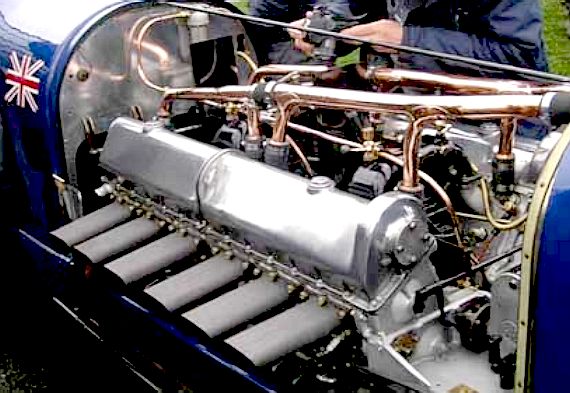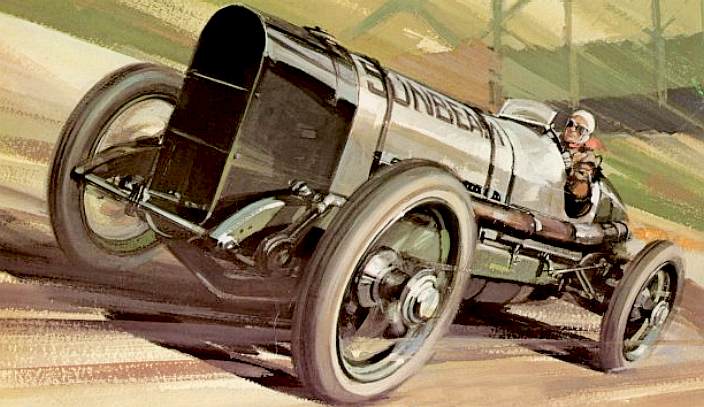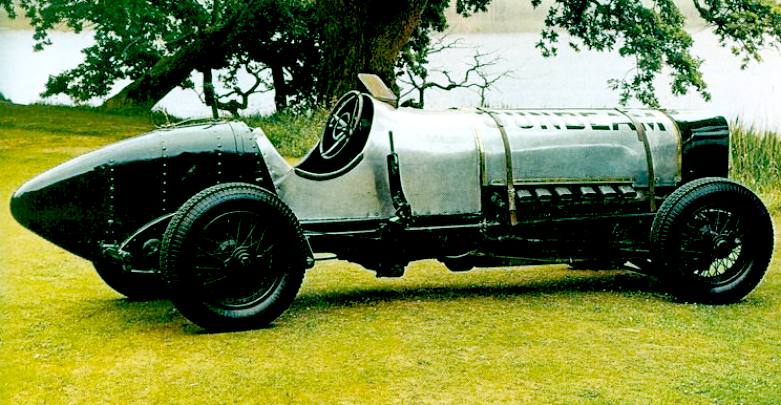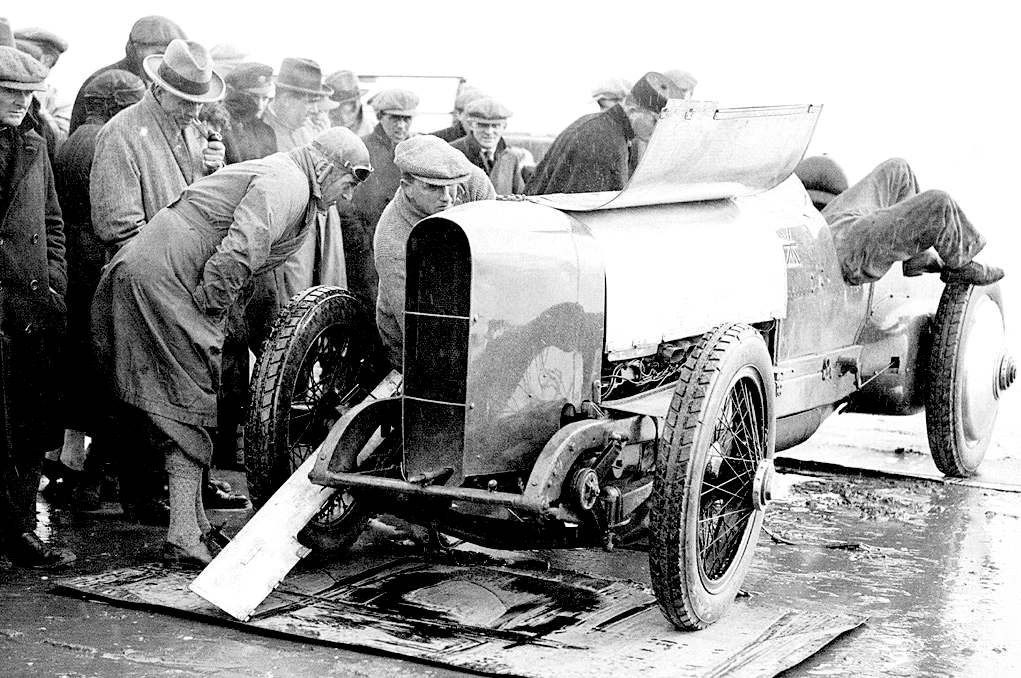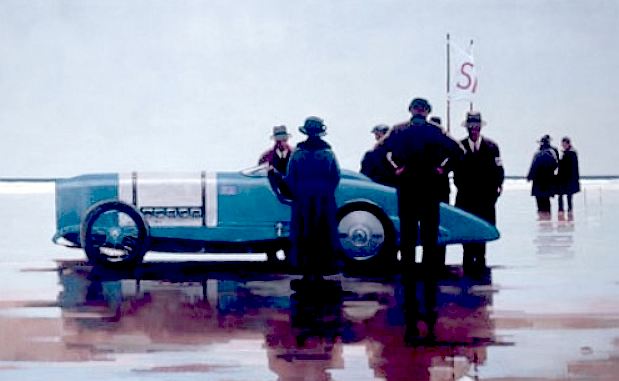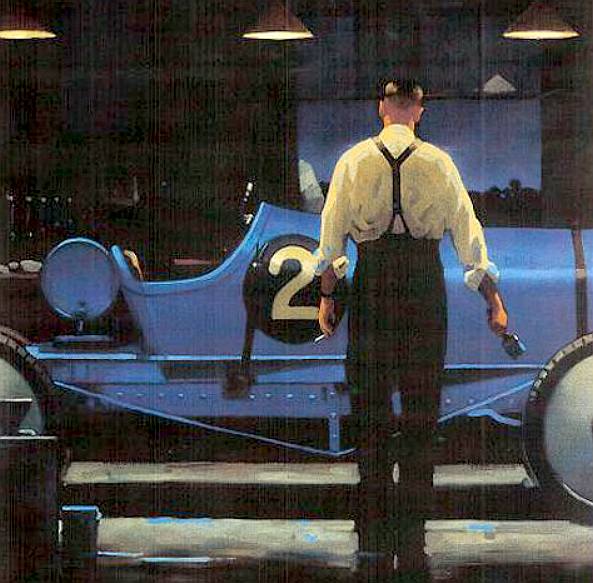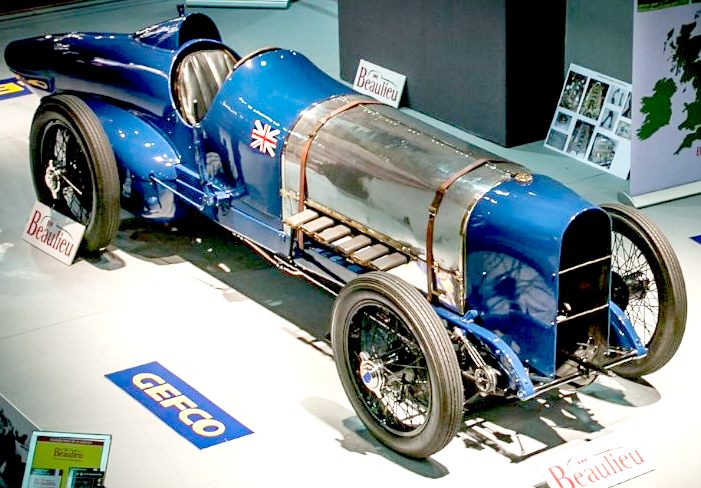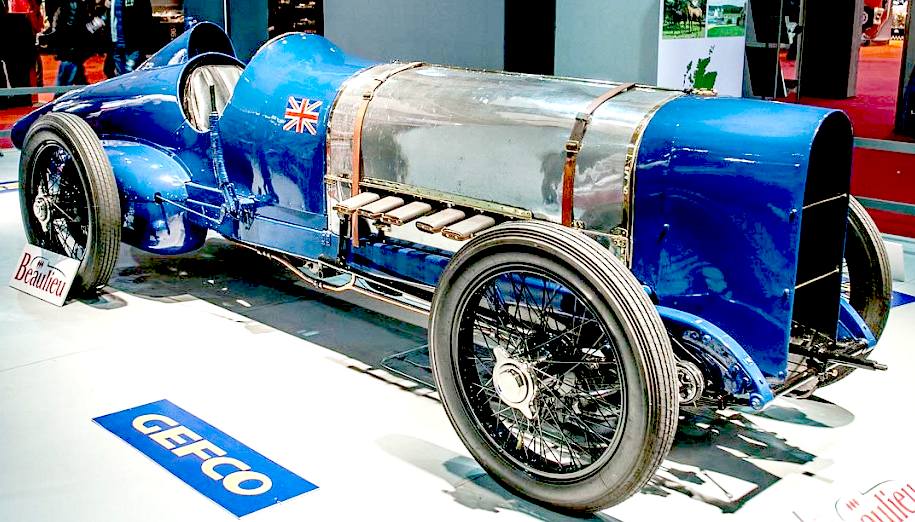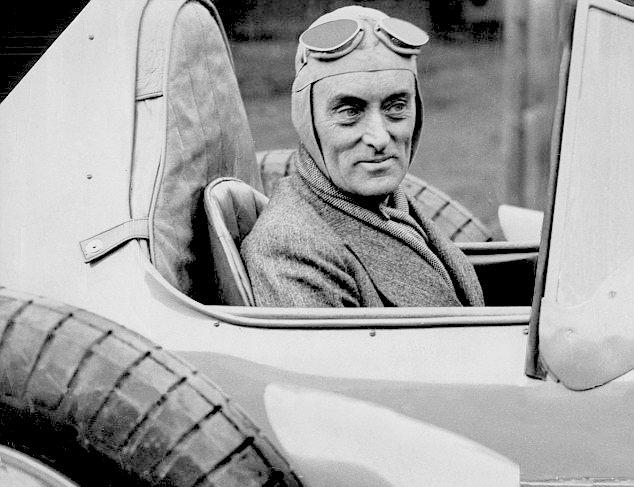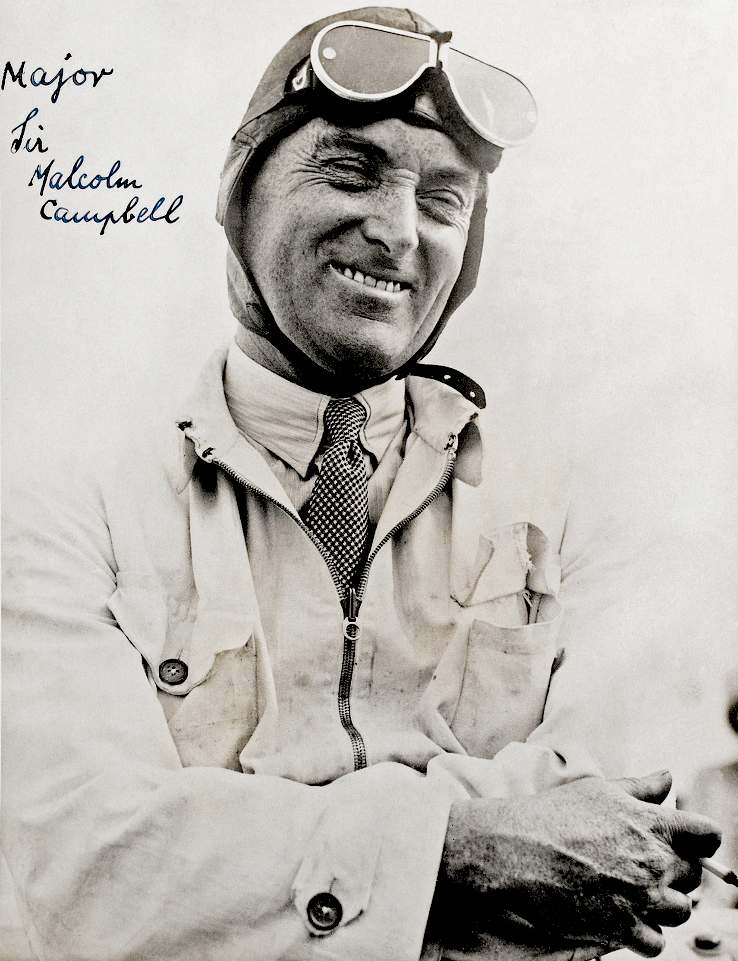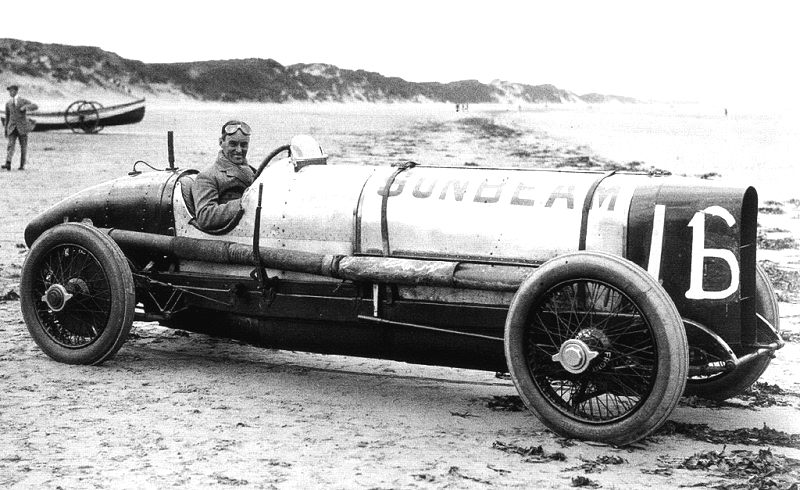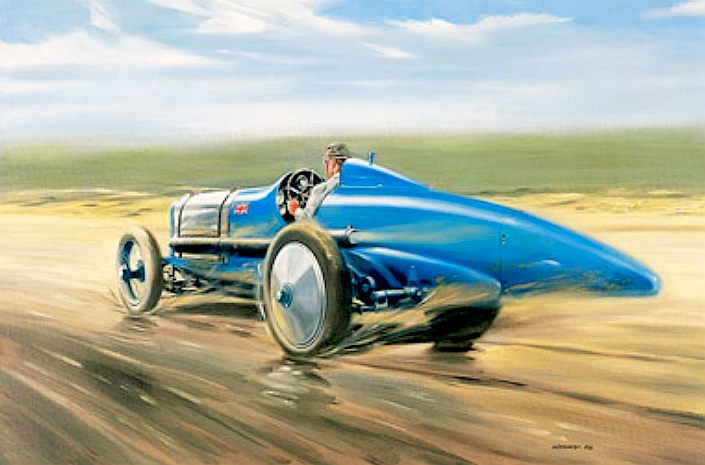|
SUNBEAM BLUE BIRD - MALCOLM CAMPBELL
|
||||||||||||||||||||||||||||||||||||||||||||||||||||||||||||||||||||||||||||||||||||||
|
Between 1922-4 Brooklands racer Captain Malcolm Campbell began his long association with the Land Speed Record. Captain Campbell borrowed the Sunbeam in 1923 to compete in the Saltburn Speed Trials, when he achieved a speed of 138mph/222.09kph. This was after the car had broken the records at Brooklands in May of 1922, when Kenelm Lee Guinness drove it on the track at 135.75 mph.
Campbell purchased and modified the 350hp car, painted it in his favourite shade of blue and named it 'Blue Bird' after his Brooklands racing cars.
The Sunbeam Blue Bird of Malcolm Campbell was a 350hp aircraft engined car, already with a significant racing pedigree.
It
was designed by Louis Coatalen and built in 1920 with drum brakes on the rear only.
Campbell has the engine modified and added
a streamlined nose cowl and pointed tail in 1924 - before Malcolm got his first official record with the car at Pendine Sands in Wales, on 25th September, 1924.
On the
Pendine Sands in South Wales
Campbell raised the record twice to 146.163 and then 150.766mph.
Campbell returned to Pendine in mid July of 1925 and so on the 21st July raised the record to 150.76 mph, becoming the first driver in the world to exceed 150 mph. To commemorate this he had some large scale models of the Sunbeam built, at least two of which are known to have survived.
Under the bonnet: the Sunbeam Manitou 350hp aircraft engine nicely restored by staff at the National Motor Museum, Beaulieu
Harry Hawker drove the car in 1920 at Brooklands and had initial problems controlling
it - spinning off the circuit. The Differential was replaced with a simple crown wheel and pinion so that the rear
wheels were locked together and it was more successful in the hands of Kenelm Lee Guinness. Brakes were crude, as was usual in the period, with a foot brake acting on the transmission and
hand brake on the rear drums. Thus, only the rear wheels were braked. Suspension was also typical, with half-elliptic springs all round damped by Andre Hartford friction shock absorbers.
The Sunbeam 350hp car at Brooklands, prior to purchase by Malcolm Campbell
Realising the limitations of the Sunbeam, Campbell set about producing an all-new Bluebird built around a 12 cylinder Napier Lion aero engine, with the aid of Reid Railton. In this car he raised the Land Speed Record to 174.883mph on 4th February 1927.
RIVAL SPEEDSTER
One of Cambell's great rivals was Major Henry Segrave. On 29th March 1927 he smashed the 200mph barrier with a new record of 203.793mph set on Daytona Beach in his 1000hp Sunbeam. Campbell knew immediately that to beat this record he would have to redesign Bluebird yet again. Using a modified version of the Lion Engine prepared for the Schneider Trophy air race and a completely new wind tunnel tested body, the car was ready by the start of 1928 and was shipped to Daytona. On 19th February, Campbell set another new record at 206.956mph. See the links below.
Sir Malcolm was not a practical mechanic, nor a designer, though he was to some extent a visionary. Consequently, he relied upon (consultant) designers and a bevy of mechanics to advise upon and service his racing vehicles. His son Donald was similar in this respect, as is Sir Malcolm's grandson, Don Wales. Donald Campbell carried with him more crew, as is apparent from the men crawling all over the CN7 during record attempts.
Over the winter of 1923–1924 the car was sent to the aircraft maker Boulton Paul at Norwich, for
wind tunnel tests. They streamlined the car with a narrow radiator cowl at the nose and a long tapered tail. The rear wheels were also fitted with disk covers. Engine compression was raised by new pistons.
Vettriano is famous for his paintings of Blue Birds: Pendine Sands
SPECIFICATIONS
ENGINE DETAILS
Cylinders: V12 Bore: 120mm Stroke: 135/142mm Cubic Capacity: 18,322cc Valves: 2 exhaust, 1 inlet, overhead camshaft Carburettors: 2 Claudel-Hobson HC7 Max. Power: 355 b.h.p. at 2,300 rpm
CHASSIS
DETAILS Suspension: elliptic springs Shock Absorbers: Hydraulic and Hartford Brakes: 18 in. diameter drum Wheels: Rudge-Whitworth wire, 880mm x 120mm
A superb representation of Malcolm Campbell admiring his handiwork, having painted the Sunbeam blue in the early hours of the morning.
THE 1920s
Following the First World War, the world of motor racing was entranced by racing cars fitted with thunderous aircraft engines. The 350hp Sunbeam is one of the most famous of this group of aero-engined giants.
Transmission was via a four speed gearbox and drive
shaft, rather then chains. It was fitted with a narrow polished aluminium single seat body with radiator cowl and tail painted in green.
The car’s first outings were plagued with teething troubles (bad luck). The very first race was scheduled to be at the 1920 Whitsun Brooklands meeting driven by Harry Hawker. But, a burst tyre caused it to crash on the Railway Straight during a practice lap. Hawker was uninjured but the car could not be raced that day.
At the Brooklands August meeting a stalled engine meant that the Sunbeam could not start its race.
In late 1920 the Sunbeam was taken to the Gaillon Hill Climb in France where René Thomas succeeded in taking the course record with a 108mph/173.81kph run on the 1km hill.
At the 1921 Brooklands Easter meeting Kenelm Lee Guinness, perhaps one of the few drivers able to get the best from the car, drove the Sunbeam for the first time. In the Lightning Short Handicap second gear was broken but this didn’t stop Guinness driving the car to second place in the Long Handicap event later the same day.
At the Autumn meeting he drove the car in both the Short and Long Handicap races. In the latter event he finished in second place but in doing so achieved speeds of 140mph/225.31kph. Disappointingly, he completed the last lap at an average speed of 116mph/186.68kph.
Few LSR cars have such a long and distinguished career after their racing days are done. The Sunbeam Blue Bird is seen here in pristine condition at a recent event, promoting Beaulieu and the National Motor Museum as a super display to those bygone days of thunder-cars.
RETIREMENT
& DISPLAY
As late as 1936, bandleader Billy Cotton recorded 121.57 mph (195.65 km/h) over a kilometre on the beach at Southport.
Harold Pratley acquired the car in 1944 and loaned it to Rootes Ltd (successors to the Sunbeam Company) who undertook a cosmetic restoration for promotional purposes.
The car may have stayed in Lancashire afterwards, turning up there during
World War 2 and then being sold to the Beaulieu collection in 1958.
ABOVE - Photo portraits of a happy man: Blue Bird happy. BELOW - The exquisite lines of the Blueplanet LSR were inspired by Reid Railton and his classic designs for the Napier Lion and Rolls Royce engined Blue Bird LSR cars in the 1930s, the Blueplanet BE3 features instant battery recharging using the patent Bluebird™ cartridge exchange system under license from BMS. This LSR car is also solar assisted. She is designed for speeds in excess of 350mph using clean electricity and could be run at Daytona Beach, Pendine Sands and other historic venues, including Bonneville. To hire the BE3 for your event, please contact BMS and ask for Leslie or Terry. The project team need at least 6 months notice of venues. The blue bird legend continues.
LINKS & REFERENCE
http://en.wikipedia.org/wiki/Sunbeam_350HP Campbell-Napier-Railton_Blue_Bird http://www.vettriano-art.com/pendine-beach/ http://en.wikipedia.org/wiki/Campbell-Napier-Railton_Blue_Bird http://en.wikipedia.org/wiki/John_Cobb_%28motorist%29 http://en.wikipedia.org/wiki/Railton_Special http://en.wikipedia.org/wiki/Crusader_%28speedboat%29 http://en.wikipedia.org/wiki/Daytona_Beach,_Florida http://en.wikipedia.org/wiki/Daytona_Beach_Road_Course History of the Daytona Beach shore Bill France, Jr.'s account of races at the track NASCAR track statistics at racing-reference.info Account of the 1957 Daytona race from winner cottonowens.com Speed TV article on Daytona’s history Profile
of Ormond Beach’s racing history
A - Z OF WORLD FAMOUS RACING CIRCUITS
The Sunbeam Blue Bird in the land speed record hall of fame at the National Motor Museum, Beaulieu around 2005. The display is frequently moved around as the cars are loaned out for various events.
TAGS
SIR
MALCOLM CAMPBELL'S BLUE BIRDS DONALD
CAMPBELL'S BLUEBIRDS
Sunbeam 350hp short tail and as the Blue Bird with a long tail and faired in cockpit
|
||||||||||||||||||||||||||||||||||||||||||||||||||||||||||||||||||||||||||||||||||||||
|
This
website is Copyright © 2015 Bluebird Marine Systems Limited.
The names Bluebird™,
Miss
Ocean™,
and the blue bird in flight
|
||||||||||||||||||||||||||||||||||||||||||||||||||||||||||||||||||||||||||||||||||||||

